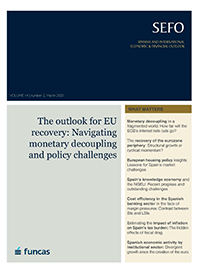The outlook for EU recovery: Navigating monetary decoupling and policy challenges
Fecha: marzo 2025
SEFO, Spanish and International Economic & Financial Outlook, V. 14 N.º 2 (March 2025)
Index
The Federal Reserve’s stable interest rate policy contrasts with the European Central Bank’s continued rate cuts aimed at stimulating weak eurozone growth. While monetary policy divergence is strengthening the dollar, albeit not consistently, and driving capital flows to the US, geopolitical fragmentation and protectionism are exacerbating economic uncertainty, generating bond market volatility and weakening global policy coordination.
Growth rates across the countries of southern Europe, once considered the weakest link in the eurozone, have outpaced the bloc’s core economies in recent years. While structural reforms have played a part, continued economic convergence within the eurozone will depend on consolidation of structural improvements, boosting productivity and resilience to global uncertainty.
Spain’s housing market is under strain due to a persistent supply-demand imbalance, particularly in major urban centers, exacerbating affordability challenges. Lessons from other European countries highlight the need to cut red tape, improve land-use policies, and foster public-private partnerships to boost housing availability and long-term market stability.
Supported by NGEU funds, Spain’s knowledge economy has made progress in key areas such as R&D investment and product innovation-related sales. However, gaps in talent formation, digitalization, and a weakening focus on sustainability threaten long-term growth unless more targeted reforms are implemented.
The sharp rise in interest rates since 2021 has driven up operating expenses for Spanish banks, making cost efficiency a key priority in the current context of slowing margin growth. A comparison between significant institutions (SIs) and less significant institutions (LSIs) highlights differences in cost structures, expense growth, and efficiency gains, with LSIs seeing more intense expense increases but also stronger improvements in efficiency.
Inflation has increased Spain’s tax burden by eroding the real value of tax allowances and pushing taxpayers into higher brackets. The lack of systematic indexation has disproportionately impacted middle-income earners, raising questions about the fairness and sustainability of current fiscal policy.
The evolution of Spain’s institutional sectors since the creation of the euro reveals significant disparities in output and capital investment. The non-financial corporate sector has driven most of the economic activity, while the current output of households barely reaches maximum 2005 levels and the fall in real corporate fixed capital since the pandemic raises concerns about long-term growth potential.

